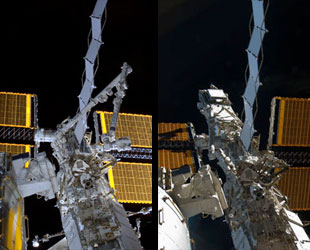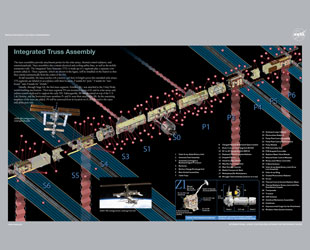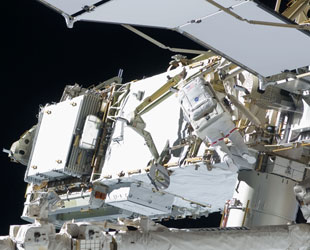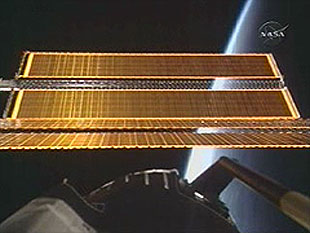|
|

|
Space station now at full length, full power

| Before and after installation of the last truss segment. (NASA) |
March 20, 2009 — Spanning the length of a football field (including the end zones) and weighing approximately the same as a loaded space shuttle orbiter, the International Space Station's (ISS) integrated truss, or backbone, was completed in orbit this week after nine years of assembly.
"We're the largest space structure in all of history and it is really amazing to be on-board," exclaimed ISS Expedition 18 commander Mike Fincke on the morning after the final piece of the truss was attached.
The 356-foot, girder-like truss supports the station's living modules and laboratories, as well as eight 115-foot solar array wings that generate as much electricity as would be needed to power 42 2,800 square foot homes.
"It is just a remarkable accomplishment for the NASA team, as well as for Boeing, which designed and built this integrated truss assembly," commented Dan Hartman, NASA's manager for the integration and operations of the space station.
Piece by piece
Eleven segments were launched by eight space shuttle missions to assemble the truss. Numbered in ascending order outward to the port (P) and starboard (S) sides, the central element, the 44-foot S0, launched in April 2002. (It was preceded to orbit by the Z1 and P6 truss segments, as the latter included a set of solar array wings that was needed to provide power during the early stages of station assembly).
The P1 and S1 thermal radiator trusses, located to either side of the S0, were launched in October and November 2002 respectively. The 45-foot segments support cooling towers used to reject heat from the station.

Next in line, the joint 44-foot P3/P4 and the mirror S3/S4 each include a set of solar array wings, a radiator, and a rotary joint enabling the arrays to track the sun. Delayed by the loss of space shuttle Columbia in February 2003, the P3 and P4 segments were added in September 2006 and, after the truss' electrical system was reconfigured by spacewalkers, the S3 and S4 were installed in June 2007.
(P2 and S2 trusses had been planned but were canceled during a redesign of the station.)
The square-shaped, 11-foot P5 and S5 segments, which were launched in December 2006 and August 2007 serve to connect the P6 and S6 segments to either end of the truss while separating the P4/S4 and P6/S6 solar arrays.
Capping the ends of the truss are the P6 and S6. First launched in November 2000, P6 was repositioned from its temporary perch atop the Z1 truss to the end of the P5 in October 2007. Its twin, the 45 foot long S6 truss segment was launched on March 15 of this year.
Full length, full power

| Steve Swanson works outside the ISS with the S6 truss (NASA) |
The S6 truss segment was maneuvered into place using the space station's robotic arm, which itself was moved into position along a cart and track system that runs most of the length of the truss.
Spacewalkers Steve Swanson and Ricky Arnold, who as part of the STS-119 mission launched with the S6 aboard shuttle Discovery, oversaw the installation from outside the ISS, bolting S6 to S5, as well as releasing restraints that held the segment's solar array wings and radiators for the ride to orbit.
"Welcome aboard, back on-board the space station, it's a lot bigger than when you left it," Fincke said, greeting the two astronauts at the end of their March 19 outing.
The next morning, flight controllers gave the go to deploy the segment's two 115-foot solar array wings, the last two of eight.
The S6 truss held the record for the longest time on the ground by any ISS element, waiting to launch since 2002. One of its two Lockheed Martin-developed arrays had been folded and packed for eight years, the other for just six. There was concern, based on earlier arrays, that the panels might stick.
Applying lessons learned from earlier deploys, the arrays were given time to "bake" in the sun before commanding their full extension.
"Today we brought up our fourth and final solar array and it was absolutely beautiful," described Fincke. "It's just really amazing. We did it very slowly, this was our fourth and last one. The first couple of ones gave us some trouble, we learned from that and made it very smoothly."

| The S6 3B array fully deployed after eight years (NASA TV) |
With all eight solar arrays extended, 262,400 solar cells now span a combined surface area of an acre. Each cell produces about one watt of power, which translates to a potential output 32.8 kilowatts for each illuminated wing.
"Full power!" announced Lee Archambault, commander of STS-119, and whose crew executed the deploy.
With the last segment in place and its wings unfurled, the challenge that was space station assembly is coming to an end.
"The solar array deploy was probably our biggest hurdle we [thought] we had in front of us," said Hartman. "There are plenty of challenges out there for us. I think we will gain new understandings of how to support a crew of six on the International Space Station, logistically and operationally, so the challenge today was the solar array, I'm sure there will be some in the future. But I think we'll be up to it."
More mission updates, see: STS-119: Flight Day Journal. |

© 2023 collectSPACE.com All rights reserved.
Questions? E-mail [email protected]

|
|

|

|
